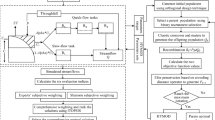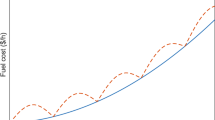Abstract
The traditional operation of the cascade hydropower stations system (CHPS) mainly focus on the maximization of power generation benefits, but ignores the interference of CHPS operation to the river ecosystem, therefore, carrying out the multi-objective optimal operation (MOOP) of CHPS considering ecological demands is crucial. In this paper, a MOOP model considering the ecological objective is established. To effectively solve the MOOP problems, a novel multi-objective Jaya algorithm (MOCOM-Jaya) is proposed, where the quality of the initial population is enhanced based on the chaotic sequence, the later disturbance term and Gaussian mutation are incorporated to improve the local search ability, the elite opposition-based learning is adopted to broaden the optimization space. The proposed algorithm is applied to the study of MOOP of CHPS in the Wujiang river, and the results show that compared with MOPSO and NSGA-II, MOCOM-Jaya can gain the solution set with better convergence and distribution for the MOOP. The competition relationship between the power generation objective (PGO) and the ecological objective (ECO) is revealed based on the partial replacement ratio method. The results show that the competitiveness of PGO and ECO experienced a trade lead with the increase of power generation. The mean competitiveness ratios of PGO to ECO (\(\overline {CP{R_{P - E}}} \) ) in three typical years (dry, normal, wet) are 3.22, 3.17 and 3.15, indicating that the PGO is dominant in the competition with the ECO as a whole.







Similar content being viewed by others
Availability of Data and Material
Streamflow data and parameters data of hydropower stations are obtained from Changjiang Water Resources Commission of the Ministry of Water Resources.
References
Alrajoula MT, Zayed ISA, Elagib NA, Hamdi MR (2016) Hydrological, socio-economic and reservoir alterations of er roseires dam in sudan. Sci Total Environ 566–567(10):938–948
Bai T, Kan YB, Chang JX, Huang Q, Chang FJ (2017) Fusing feasible search space into pso for multi-objective cascade reservoir optimization. Appl Soft Comput 51:328–340
Cai W, Zhang L, Zhu X, Zhang A, Yin J, Wang H (2013) Optimized reservoir operation to balance human and environmental requirements: a case study for the three gorges and gezhouba dams, yangtze river basin, china. Ecol Inform 18:40–48
Choong SM, El-Shafie A, Wan Mohtar WHM (2017) Optimisation of multiple hydropower reservoir operation using artificial bee colony algorithm. Water Resour Manag 31(4):1397–1411
Deitch M, Merenlender A, Feirer S (2013) Cumulative effects of small reservoirs on streamflow in northern coastal california catchments. Water Resour Manag 27:5101–5118
Elliott A, Hynan L (2010) A sas (r) macro implementation of a multiple comparison post hoc test for a Kruskal-Wallis analysis. Comput Methods Programs Biomed 102:75–80
Hassaballah K, Jonoski A, Popescu I, Solomatine DP (2012) Model-based optimization of downstream impact during filling of a new reservoir: case study of mandaya reservoirs on the blue nile river. Water Resour Manag 26(2):273–293
He YY, Zhou JZ, Xiang XQ, Chen H, Qin H (2009) Comparison of different chaotic maps in particle swarm optimization algorithm for long-term cascaded hydroelectric system scheduling. Chaos Solitons & Fractals 42(5):3169–3176
Hecht JS, Vogel RM, McManamay RA, Kroll CN, Reed JM (2020) Decision trees for incorporating hypothesis tests of hydrologic alteration into hydropower–ecosystem tradeoffs. J Water Resour Plan Manag 146:5
Hu H, Yang K, Su L, Yang Z (2019) A novel adaptive multi-objective particle swarm optimization based on decomposition and dominance for long-term generation scheduling of cascade hydropower system. Water Resour Manag 33:4007–4026
Jia W, Dong Z, Duan C, Ni X, Zhu Z (2019) Ecological reservoir operation based on dfm and improved pa-dds algorithm: a case study in Jinsha river, China. Human Ecol Risk Assess: Int J 26:1–19
Jiang Z, Changming Q, Hui F, Zhongkai (2018) Multi-stage progressive optimality algorithm and its application in energy storage operation chart optimization of cascade reservoirs. Energy 148:309–323
Knowles J, Corne D (2002) On metrics for comparing non-dominated sets. In: Proceedings of the 2002 congress on evolutionary computation, CEC 2002, vol 1, pp 711–716
Li C, Ling K (2014) A new modified tennant method with spatial-temporal variability. Water Resour Manag 28(14):4911–4926
Li FF, Qiu J (2016) Multi-objective optimization for integrated hydro–photovoltaic power system. Appl Energy 167:377–384
Li J, Xia Z, Ma G, Guo L (2007) A new monthly frequency computation method for instream ecological now. Acta Ecologica Sinica 027(007):2916–2921
Meiner T, Schütt M, Sures B, Feld CK (2018) Riverine regime shifts through reservoir dams reveal options for ecological management. Ecol Appl 28 (7):1051–0761
Mekni S, Chaar Fayech B (2015) Multiobjective flexible job shop scheduling using a modified invasive weed optimization. Int J Soft Comput 6(1):25–36
Moeini R, Soltani-Nezhad M, Daei M (2017) Constrained gravitational search algorithm for large scale reservoir operation optimization problem. Eng Appl Artif Intel 62(06):222–233
Rao RV, Saroj A (2017) Constrained economic optimization of shell-and-tube heat exchangers using Elitist-Jaya algorithm. Energy 128(04):785–800
Rao RV, Rai DP, Balic J (2017) A multi-objective algorithm for optimization of modern machining processes. Eng Appl Artif Intel 61:103–125
Reddy MJ, Kumar DN (2007) Multi-objective particle swarm optimization for generating optimal trade-offs in reservoir operation & nbsp. Hydrol Process 21(21):2897–2909
Santos NCLD, García-Berthou E, Dias JD, Lopes TM, Agostinho AA (2018) Cumulative ecological effects of a neotropical reservoir cascade across multiple assemblages. Hydrobiologia 819(4):77–91
Schott JR (1995) Fault tolerant design using single and multicriteria genetic algorithmoptimization. Cell Immunol 37(1):1–13
Scott Steinschneider, Alec Bernstein, Richard Palmer, Austin Polebitski (2014) Reservoir management optimization for basin-wide ecological restoration in the connecticut river. J Water Resour Plan Manag 140:9
Sharma TK, Pant M (2018) Opposition-based learning embedded shuffled frog-leaping algorithm. 01 soft computing: theories and applications. Springer, Singapore
Sichilalu S, Wamalwa F, Akinlabi ET (2019) Optimal control of wind-hydrokinetic pumpback hydropower plant constrained with ecological water flows. Renew Energy 138(08):54–69
Szabo-Meszaros M, Navaratnam CU, Aberle J, Silva AT, Alfredsen K (2018) Experimental hydraulics on fish-friendly trash-racks: an ecological approach. Ecol Eng 113:11–20
Tayebiyan A, Ali TAM, Ghazali AH, Malek MA (2016) Optimization of exclusive release policies for hydropower reservoir operation by using genetic algorithm. Water Resour Manag 30(3):1203–1216
Teegavarapu RSV, Ferreira AR, Simonovic SP (2013) Fuzzy multiobjective models for optimal operation of a hydropower system. Water Resour Res 49(6):3180–3193
Venkata Rao R (2016) Jaya: a simple and new optimization algorithm for solving constrained and unconstrained optimization problems. Int J Ind Eng Comput 7(01):19–34
Warid W, Hizam H, Mariun N, Abdul Wahab NI (2018) A novel quasi-oppositional modified Jaya algorithm for multi-objective optimal power flow solution. Appl Soft Comput 65(02):360–373
Yu X, Hui S, Hui W, Zuhan L, Jia Z, Tianhui Z, Hui Q (2016) Multi-objective sustainable operation of the three gorges cascaded hydropower system using multi-swarm comprehensive learning particle swarm optimization. Energies 9(6):438
Zhang Q, Cui Y, Chen Y (2010) Evaluation of ecological instreamf flow of the pearl river basin, South China. Ecol Environ 019(008):1828–1837
Zhiqiang J, Hui Q, Changming J, Zhongkai F, Jianzhong Z (2017) Two dimension reduction methods for multi-dimensional dynamic programming and its application in cascade reservoirs operation optimization. Water 9(9):634
Zitzler E, Deb K, Thiele L (2000) Comparison of multiobjective evolutionary algorithms: empirical results. Evol Comput 8(2):173–195
Acknowledgements
The research was funded by the National Key Research & Development Project of China(2016YFC0402209)
Funding
The research was funded by the National Key Research & Development Project of China(Grant number: 2016YFC0402209).
Author information
Authors and Affiliations
Contributions
All authors contributed to the study conception and design. Material preparation, data collection and analysis were performed by Yiming Wei. Zengchuan Dong helped perform the analysis with constructive discussions. Zengchuan Dong is the recipient of the funding. The first draft of the manuscript was written by Yiming Wei and all authors commented on previous versions of the manuscript. All authors read and approved the final manuscript.
Corresponding author
Ethics declarations
This article does not contain any studies with human participants or animals performed by any of the authors.
Conflict of interests
The authors declare that they have no competing Interests.
Additional information
Publisher’s Note
Springer Nature remains neutral with regard to jurisdictional claims in published maps and institutional affiliations.
Rights and permissions
About this article
Cite this article
Wei, Y., Dong, Z. Application of a Novel Jaya Algorithm Based on Chaotic Sequence and Opposition-based Learning in the Multi-objective Optimal Operation of Cascade Hydropower Stations System. Water Resour Manage 35, 1397–1413 (2021). https://doi.org/10.1007/s11269-020-02731-0
Received:
Accepted:
Published:
Issue Date:
DOI: https://doi.org/10.1007/s11269-020-02731-0




